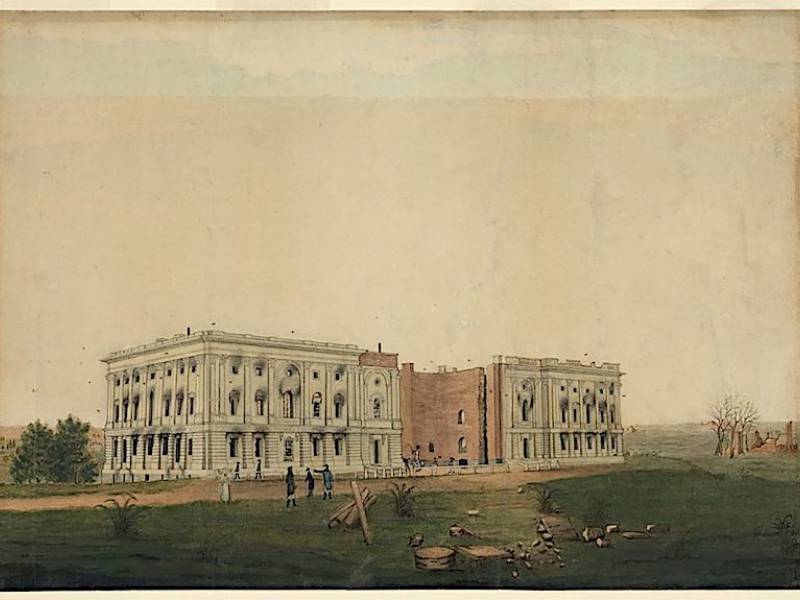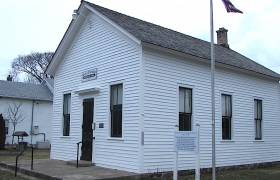Cruise on over to this celebration of of...
The ‘People’s Houses’ are endangered in Washington and at home
The events of Jan. 6 brought to mind two incidents in American history – on opposite sides of the political spectrum.
By now we’ve all seen the images and wrestled with the sobering reality that five people lost their lives after protestors breached the building in a failed attempt to derail certification of the November 2020 election by Congress. In the melee, doors and windows were damaged, desks tipped over and photographs torn from the walls. Early repair estimates, excluding labor, place repairs between $270,000 and $350,000.
Who knows how much damage was done during the President Andrew Jackson’s inauguration of 1829.
A White House Historical Association account, written by David and Jeanne Heider, noted:
“The surging crowd made mingling impossible, and as people pushed toward Jackson and lunged toward refreshments, they collided with fragile furniture and shoved servants laden with punch bowls and trays of food. Waiters trying to maneuver with a large bowl of spiked orange punch crashed into a crowd and spilled it all on the carpet. Men in work boots, straining to see Jackson, stood on expensive upholstered furniture. That such people were even present at so august an event represented the triumph of democracy to some. To others, the much-reported mayhem demonstrated the danger of giving the ungovernable rabble political rights.”
Amid the War of 1812, an invading British force set fire to a number of public buildings in Washington, including the Capitol, on Aug. 24, 1814. The flames, fanned by furniture and wooden window frames left our nation’s still largely rural capital in rubble and destroyed an estimated 3,000 documents in the Library of Congress. Only a torrential rain prevented the Capitol from being completely destroyed.
An account by Washington resident Margaret Bayard Smith noted, “windows were broken and this wild-fire thrown in, so that an instant conflagration took place and the whole building was ‘wrapt’ in flames and smoke. The spectators stood in awful silence, the city was light and the heavens redden’d with the blaze!”
Thankfully, last week’s assault was not nearly as devastating to the building. Left free to ransack Congressional offices and scatter papers across the floor, but for a lighter, it could have been.
•••
The McHenry County Conservation District Board’s Finance and Administrative Committee will meet virtually 5 p.m. Tuesday, Jan. 12, to discuss spending $45,000 for roof repairs on the 40-stall, transverse-frame dairy barn it owns in Richmond.
The barn is among a number of historic buildings on this 9 acres off Broadway Road – including a massive, three-bay threshing barn that features 16-inch, hand-hewn oak beams – thought to be part of a living history museum.
But those plans, as well as a master plan for the Fox Bluff Conservation Area near Algonquin, are in jeopardy because of shrinking levy authority, finite staff, rules that restrict the sale of district-owned properties and potential uses of these historic structures for programming or administrative functions.
Last month, staff presented a “Historic Structure Stabilization Report” providing a snapshot of the 27 remaining historic structures MCCD owns.
It was recommended that just six structures: the Camp Algonquin recreation hall; the Powers-Walker House and Wiedrich Barn in Glacial Park; and the McConnell farmstead house, chicken coop and granary be maintained going forward.
Among the buildings not making the cut were all 12 buildings on the Pichen farmstead near The Hollows Conservation Area in Cary; a turn-of-the-century dormitory and barn in the former Camp Algonquin; and the Kennedy Way Station north of Woodstock – plaqued by the McHenry County Historical Society in 1982.
The conservation district acquired these properties knowing full well that the Illinois Conservation District Act specifically calls for the “revitalization or rehabilitation of historic structures” in addition to preserving and maintaining open space. But it insists that circumstances have changed and that it does not have the money necessary right now.
Staff estimates it will cost $70,000 in the next five years to stabilize Tribune Dormitory 2 and $60,000 to fix the dairy barn/spring house at the former fresh air camp; $50,000 to repair the Kennedy Way Station and $77,000 to fix a large barn, milk house and two silos on the McConnell farmstead. Assuming these buildings remain standing by 2026, bonds will be retired and it can once again approach taxpayers.
The events of Jan. 6 brought to mind two incidents in American history – on opposite sides of the political spectrum.
By now we’ve all seen the images and wrestled with the sobering reality that five people lost their lives after protestors breached the building in a failed attempt to derail certification of the November 2020 election by Congress. In the melee, doors and windows were damaged, desks tipped over and photographs torn from the walls. Early repair estimates, excluding labor, place repairs between $270,000 and $350,000.
Who knows how much damage was done during the President Andrew Jackson’s inauguration of 1829.
A White House Historical Association account, written by David and Jeanne Heider,noted:
“The surging crowd made mingling impossible, and as people pushed toward Jackson and lunged toward refreshments, they collided with fragile furniture and shoved servants laden with punch bowls and trays of food. Waiters trying to maneuver with a large bowl of spiked orange punch crashed into a crowd and spilled it all on the carpet. Men in work boots, straining to see Jackson, stood on expensive upholstered furniture. That such people were even present at so august an event represented the triumph of democracy to some. To others, the much-reported mayhem demonstrated the danger of giving the ungovernable rabble political rights.”
Amid the War of 1812, an invading British force set fire to a number of public buildings in Washington, including the Capitol, on Aug. 24, 1814. The flames, fanned by furniture and wooden window frames left our nation’s still largely rural capital in rubble and destroyed an estimated 3,000 documents in the Library of Congress. Only a torrential rain prevented the Capitol from being completely destroyed.
An account by Washington resident Margaret Bayard Smith noted, “windows were broken and this wild-fire thrown in, so that an instant conflagration took place and the whole building was ‘wrapt’ in flames and smoke. The spectators stood in awful silence, the city was light and the heavens redden’d with the blaze!”
Thankfully, last week’s assault was not nearly as devastating. Left free to ransack Congressional offices and scatter papers across the floor, but for a lighter, it could have been.
•••
The McHenry County Conservation District Board’s Finance and Administrative Committee will meet virtually 5 p.m. Tuesday, Jan. 12, to discuss spending $45,000 for roof repairs on the 40-stall, transverse-frame dairy barn it owns in Richmond.
The barn is among a number of historic buildings on this 9 acres off Broadway Road – including a massive, three-bay threshing barn that features 16-inch, hand-hewn oak beams – thought to be part of a living history museum.
But those plans, as well as a master plan for the Fox Bluff Conservation Area near Algonquin, are in jeopardy because of shrinking levy authority, finite staff, rules that restrict the sale of district-owned properties and potential uses of these historic structures for programming or administrative functions.
Last month, staff presented a “Historic Structure Stabilization Report” providing a snapshot of the 27 remaining historic structures MCCD owns.
It was recommended that just six structures: the Camp Algonquin recreation hall; the Powers-Walker House and Wiedrich Barn in Glacial Park; and the McConnell farmstead house, chicken coop and granary be maintained going forward.
Among the buildings not making the cut were all 12 buildings on the Pichen farmstead near The Hollows Conservation Area in Cary; a turn-of-the-century dormitory and barn in the former Camp Algonquin; and the Kennedy Way Station north of Woodstock – plaqued by the McHenry County Historical Society in 1982.
The conservation district acquired these properties knowing full well that the Illinois Conservation District Act specifically calls for the “revitalization or rehabilitation of historic structures” in addition to preserving and maintaining open space. But it insists that circumstances have changed and that it does not have the money necessary right now.
Staff estimates it will cost $70,000 in the next five years to stabilize Tribune Dormitory 2 and $60,000 to fix the dairy barn/spring house at the former fresh air camp; $50,000 to repair the Kennedy Way Station and $77,000 to fix a large barn, milk house and two silos on the McConnell farmstead. Assuming these buildings remain standing by 2026, bonds will be retired and it can once again approach taxpayers.
• Kurt Begalka, former administrator of the McHenry County Historical Society & Museum in Union.
Published Jan. 11, 2021, in the Northwest Herald
 © 2025 MCHS- All Rights Reserved.
© 2025 MCHS- All Rights Reserved.















